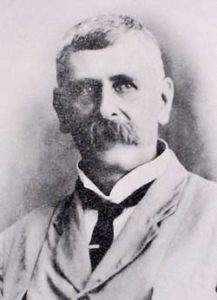Homestretch Avenue was built on the ‘homestretch’ of the former D’Urban Park Race Course, named after Governor Benjamin D’Urban.

Photo: John Oxley Library, State Library, Qld
Benjamin D’Urban’s tomb can be found in Pointe Claire’s Field of Honour, Canada. The Papineau cemetery, where his remains were originally buried, was in the way of building a new access ramp to a bridge. D’Urban’s remains, along with those of other Canadian soldiers who have served internationally since the 18th century, were transferred in 1944 to Last Post Fund’s National Field of Honour in Pointe Claire, Montreal, Canada.
Durban, in South Africa’s KwaZulu-Natal province, is also named after Sir Benjamin D’Urban, who was also governor of the territory.
A museum displaying the history of the Guyana Police Force was founded in 1932, but left neglected until 1975, when it was resuscitated by John Campbell, a writer who ‘undertook the task of redesigning’ the museum. The John Campbell Police Museum reopened in 1993 near Eve Leary in Georgetown.
The first Europeans to settle in Guyana were the Dutch who cultivated cotton. Sugar was first produced on the Pomeroon River at the village of New Middelburg.
On May 27, 1938 American pilot and mechanic, Art Williams, along with John Henry Hunterm, registered a new company in British Guiana called the British Guiana Airways Limited.
In July 1955, the colonial government purchased B.G. Airways Limited and renamed it the British Guiana Airways (Government).
On September 1, 1963, the Guyana Airways Corporation, established under the Public Corporations Ordinance, took over operations of the B.G. Airways (Government).
In 1965, the entire G.A.C. operations were moved to the Atkinson Airfield, now known as the Cheddi Jagan International Airport, or the Timehri International Airport. Flight operations had previously been carried out at the then Mackenzie Airport, Ruimveldt and Atkinson Field.

According to Lloyd Luckhoo, Guyana is the only country in the world in which the Prince of Wales (in 1920) and Her Majesty the Queen (in 1966) actually attended race meetings – the Prince at Bel Air Park and Queen Elizabeth at D’Urban Park.
In 1943, Vincent Roth became the curator of the Guyana (British Guiana) Museum. He also established the zoo in the Botanical Gardens. Roth arrived in British Guiana in 1907, when he was 18 years old, after completing his schooling in Tasmania. He joined his father, Dr Walter Roth, who had taken up the post of Government Medical Officer in the North West District of British Guiana in 1907. Vincent Roth departed for Barbados in 1964, and died in 1967.
In 1906, Walter Roth was made protector of Indians in the Pomeroon district of British Guiana. In 1924, his valuable work, “An Introductory Study of the Arts, Crafts, and Customs of the Guiana Indians” was published. Roth retired from the government service in 1928, and became curator of the Georgetown museum of the Royal Agricultural and Commercial Society, and government archivist.

The Walter Roth Museum of Anthropology in Georgetown, Guyana has been named in his honour.
The city once used a tram service around the town. It began and ended on the Georgetown Seawalls.
Bourda Green was once called ‘Bourda Pasture’. It was a neglected field before becoming a favourite spot for large political meetings. From the late 1940s and into the 1950s, Dr Cheddi Jagan and Forbes Burnham addressed mass meetings there calling for an independent Guyana during various rallies.
In 1891, Lady Gormanston turned on the first electric lights in British Guiana.
On July 17, 1879 Lady Kortright, wife of Governor Cornelius Hendricksen Kortright, ceremoniously lay the foundation stone of Stabroek Market.
The Town Hall (now the City Hall) was opened in 1889 in the city of Georgetown.
Members of a geological survey team, which included C. Barrington Brown, a British geologist, discovered the Kaieteur Falls on the Potaro River on April 24, 1870.
Pvt. Robert Howat of the Scottish Black Watch took the most dangerous dip on record when he swam across the top of Guyana’s Kaieteur Falls in 1955, drawn by both the challenge and the flower blossoms on the far bank. Howat was on the final leg of his risky round trip and “hungry for dinner” when he got caught in a whirlpool and was spat out toward the world’s highest sheer drop-off of water.
“I drifted almost to the lip and was rescued by an Amerindian as I was holding on to weeds 10-15 yards (metres) from the edge,” the former infantryman in the crack Highland regiment said by telephone from Lichfield, England.
“It was put into the Guinness Book of World Records in 1970-71 as the most dangerous swim recorded, but it was taken out again in 1980 because they didn’t want anyone else attempting it,” said Howat, who was 25 when he took the plunge. To date no one else has gone to such extremes to get a bird’s-eye view of the gargantuan waterfall. (forests.org)



